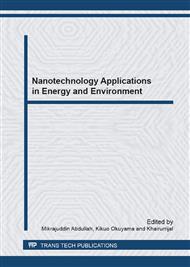p.110
p.119
p.126
p.133
p.137
p.145
p.153
p.159
p.166
Performance of TiO2 Aggregates-Based Dye Solar Cells
Abstract:
TiO2 aggregates-based dye solar cells (DSCs) have gained an increasing interest due to their better light harvesting efficiency as a result of enhanced light scattering effect from the submicron spherical aggregates that can generate more electrons and the high internal surface area for dye chemisorption provided by nanocrystallites which made up the aggregates. Optimized TiO2 aggregates (0.45 µm) composing of nanocrystallites (10-40 nm) with desired physicochemical properties for enhanced overall light conversion efficiency of DSC were synthesized by varying the calcination temperature and water content in the hydrolysis of titanium alkoxide in ethanol. TiO2 aggregates obtained were characterized using FESEM, XRD and UV-Vis spectroscopy. The assembled DSCs were then evaluated using solar simulator under AM 1.5 (100 mW/cm2) simulated sunlight. Nanocrystallites were found to have an increasing size of 12 nm to 36 nm with increasing calcination temperature of 400C to 600C. Sample of aggregates calcined at 500C recorded the highest efficiency (4.456%) as the 20-nm nanocrystallites produced is considered to be the optimum size for dye absorption. With higher water content in the hydrolysis process, the aggregates lose their spherical shapes resulting in lower absorption intensity indicating the occurrence of low light scattering in the TiO2 film. Highest conversion efficiency was observed for DSC that used well-defined spherical TiO2 aggregates composing of 20-nm nanocrystallites which were synthesized using ethanol with low water content (0.9 vol%) followed by calcination at 500C. Thus, optimized TiO2 nanocrystallites which form spherical aggregate is critical in order to improve light harvesting efficiency of DSCs.
Info:
Periodical:
Pages:
137-144
Citation:
Online since:
January 2013
Authors:
Keywords:
Price:
Сopyright:
© 2013 Trans Tech Publications Ltd. All Rights Reserved
Share:
Citation:



